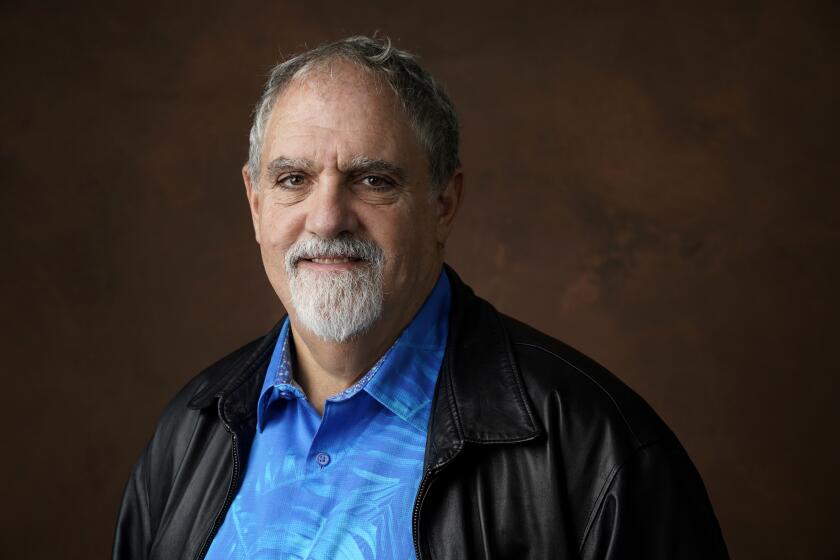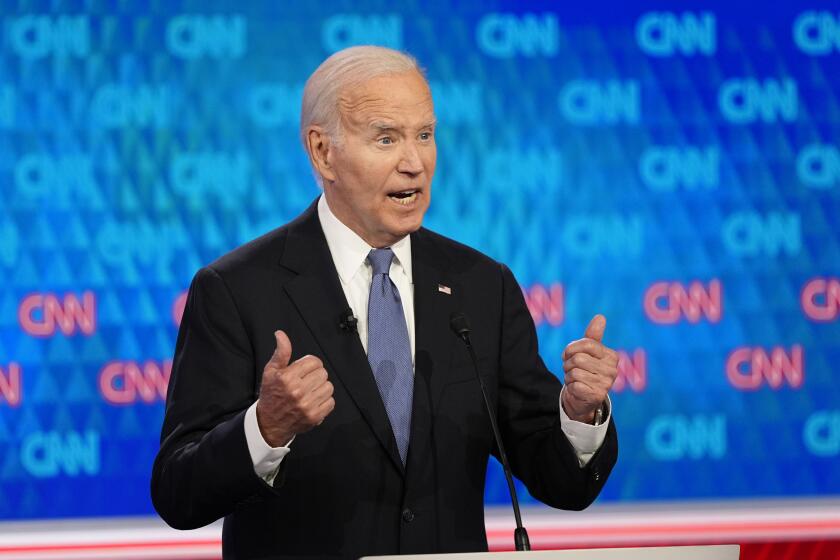Ram Dass Reborn : This Time, Teacher of Selfless Service Turns to Social, Political Activism
“Somehow we found ourselves talking about Ram Dass’ funeral. I said the name of the funeral would have to be ‘Be Dead Now’ (after Ram Dass’ best - selling book ‘Be Here Now’). Bob Dylan has a line in a song somewhere about he who isn’t busy being born is busy dying. There’s not that many people who, at 60, are still busy being born. Ram Dass is still being born.” --political activist Paul Gorman, co-author with Ram Dass of “How Can I Help?”
Social action quiz for the ‘90s:
1. Can you still make a real contribution to society--something that makes a profound difference--in a nation whose heroes are H. Norman Schwarzkopf, Bart Simpson and Madonna?
2. Can you walk by the homeless on the street and keep an open heart? Do you ignore them for the sake of your safety? Is it politically correct to invite them home for a shower and a Big Mac?
3. If you choose to serve the disadvantaged--or even the over-privileged--can you do it for any length of time without winding up as burned out or as depressed as those you seek to help?
These are some of the questions being hotly debated--and, later, acted upon--in Wednesday night sessions in the cavernous Scottish Rite Temple here. The forum for the inquiries, “Reaching Out,” is an innovative, 10-week experiment in community service.
But this is no small-time, one-shot undertaking limited to the East Bay. For the last seven Wednesday evenings, more than 1,100 participants have shown up for these ‘90s-style love-ins. So have TV cameras. Performers like Arlo Guthrie and Peter Gabriel have come by to sing a song or two. Bob Weir of the Grateful Dead and Bobby “Don’t Worry, Be Happy” McFerrin will appear in the final weeks. And the Dalai Lama dropped in via videotape.
Center stage is a guy who’s made his name in the psychological and spiritual arenas. Now, he’s branching out into social and political activism, but insists he’s still more comfortable talking about unconditional love than motivating his listeners to tackle nuclear waste disposal.
He is known--this year at least--as Ram Dass, the teacher and writer who’s spent a quarter of a century translating Eastern spirituality in terms that Westerners can understand. His books have sold nearly 3 million copies. And although he has discouraged people from becoming his devotees, he has thousands of fans, if not followers, throughout the world.
“Reaching Out” is Ram Dass’ new course designed to catalyze people who wish to be of greater service to the world--whether they are doling out sandwiches at the local food bank or raising money to save the rain forests. The program represents a distinctly different incarnation for the pop culture pioneer who’s been reborn so many times it’s getting hard to keep track.
Perhaps you remember him as Richard Alpert from the ‘60s. The young, up-and-coming Harvard psychology professor. The self-described overachieving neurotic who soared into bliss with his pal Timothy Leary as they personally researched the effects of LSD and other hallucinogens.
They quickly became the counterculture’s psychedelically correct superstars. But Harvard didn’t much appreciate the pair’s up-front-in-your-face style of research (dispensing LSD to graduate students) and booted them off the faculty in 1963.
In 1967, after six years of relentlessly getting high, Alpert took off for India in search of non-chemical nirvana.
He recently described that continuing quest at a “Reaching Out” fund-raiser in Los Angeles. “Back in the ‘60s, through medical intervention,” he began, immediately interrupted by laughter, “I experienced altered states in which I realized that we are all one. The problem with medications is that they do tend to wear off. I have spent the last 30 years trying to integrate that realization into my life.”
By the end of the ‘60s, Alpert had apprenticed himself to a guru, the late Neem Karolie Baba, who renamed him Ram Dass (“servant of God”). A full-dress yogi (beads, robe, beard, bare feet), Ram Dass preached meditation, yoga, chanting and Eastern-style purification practices. Followers in the West soon added the traditional Indian title Baba (“holy father”) to his name, and he did not object.
Baba Ram Dass began to crank out best-selling books. In “Be Here Now,” for instance, a wild-eyed, autobiographical “cookbook for a sacred life,” he presented his readers with a huge section of the text written and illustrated in rubber-stamp art. The book, published in 1971, has sold more than 900,000 copies. It explained its author this way: “Since his most recent return to the West from India, he has been floating about on an ocean of love . . . carried by the winds of desire of beings he can serve.”
Baba Ram Dass made a living, and raised funds for his far-flung projects, by continuing to write, lecture, travel and float. By 1974, he had created the Hanuman Foundation, through which he began the “Prison Ashram Project” (to help prisoners use confinement as a path to enlightenment, much as monks in monasteries do) and the “Dying Project” (to create environments where people can use dying as the ultimate growth process).
Next, he and some friends created the Seva Foundation, noted for its work with the blind in Nepal and India, impoverished villagers in Guatemala, refugees in Mexico and the homeless in New York City.
(Ram Dass is no longer active in all these projects, but he’s still connected with most of the them. Seva, he said, operates on a budget of about $1.25 million a year, most of which is contributed in small but regular chunks by the 30,000 individuals on its mailing list. The Hanuman Foundation, he added, has no budget; he termed it a “tax umbrella” that allows him to give away money he receives from lecturing and book royalties.)
By the mid-’70s, however, despite all his good deeds, Baba Ram Dass’ ocean of love appeared to slip down the toilet. He was busted by--of all things--the budding New Age community that had installed him as one of its earliest and most revered heroes.
From 1974 to 1976, he teamed up with a Brooklyn trance channeler and touted her mystical abilities, including copious bleeding from the mouth that he referred to as “stigmata.” But in an article for Yoga Journal titled “Egg on My Beard,” he confessed that he’d been duped. She was a fraud. He was an idiot.
Somewhere thereabouts--he doesn’t recall exactly when--Baba Ram Dass weathered yet another identity crisis. He ditched the “Baba” or holy father portion of his name and became plain old Ram Dass.
Later, for a brief time in the mid-’80s, he resurrected the name Richard Alpert. But it too no longer fit, and he went back to Ram Dass. Among the other reasons for the change, his publishers dutifully reminded him that the name Richard Alpert does not sell books. (To date, Alpert has written three books to Ram Dass’ seven; “Compassion in Action,” Ram Dass’ latest, is scheduled for release this fall.)
By the late ‘80s, Ram Dass had expanded his audience beyond leftover hippies and New Age meditators. He added to the fold many Americans who would probably never subject themselves to the “ dharma (appropriate action) talks” he still gives throughout the country. (This Saturday and Sunday he will present a workshop complete with dharma talks, chanting and meditation at the Scottish Rite Temple in Los Angeles.)
These new, decidedly more mainstream members of the Ram Dass audience were introduced to him through “How Then Shall We Live?” a nine-part television series that aired on more than 60 PBS stations from 1986 through 1988. Ram Dass, and his work with dying people and their caretakers, were the subject of the first four parts of the series.
Joseph Tieger, co-producer of “How Then Shall We Live?” is the executive producer for the video version of “Reaching Out.” The production is being funded with about $500,000, most of which was raised by Ram Dass.
Other funds came from the $100 tuition that “Reaching Out” participants pay for their classes. But Tieger estimates it will take another $500,000 to complete post-production.
While there is no guarantee PBS stations will air the “Reaching Out” series, Tieger expects them to accept it. He added that one Bay Area PBS station offered to air all 10 weeks of the “Reaching Out” course live. But those behind the project chose instead to tape now, edit later and present the course in a more polished fashion, ready for broadcast in 1992.
Over a fish and noodles lunch at a Cambodian restaurant the day after “Reaching Out’s” first session, Ram Dass was explaining what had led him to this new venture.
He cited the potential of reaching a wider audience through television. And he recalled the satisfaction he felt working with the homeless in New York City in the late ‘80s.
Ram Dass is 60. For the last three years, he has been a resident of Marin County, original hot-tub territory. He rents the carriage house of a friend’s home in San Anselmo, a place he shares with a cat and a man whom he asked not be identified.
Because he’s still on the road for about nine months of the year, he’s given up the strict vegetarian diet he once followed and was enjoying his fish immensely. He said many of the rigorous, devotional practices (intense hatha yoga breathing, long fasts) that were once a part of his regimen have similarly vanished, although he still meditates daily.
Unlike the lean yogi with the long, frizzy beard, the Ram Dass of the ‘90s appears altogether conventional, an elder who might be mistaken for Grandpa Walton. He’s got a little paunch and favors crew-neck sweaters, oxford-cloth shirts and top-quality, nondescript cotton pants. On this day, his beads were discreetly tucked away in a pants pocket. And what was left of his glistening white hair was relatively short and combed straight back.
He drives an old, rusted Mercedes he inherited from his late stepmother. Asked if he’s attached to material objects, he shot back: “As long as you don’t get near my MG.” Then he volunteered that he lives rather comfortably on about $50,000 a year and donates the rest of his income to his foundations. As for his current spiritual identification, he laughed and categorized himself as “Hinju,” half Hindu, half Jew. Then he got serious about how he’s struggling with the same, spiritually based issues he’s asking those enrolled in “Reaching Out” to examine.
As he said on opening night, “This course is both for people who are feeling the pain in their hearts that they don’t know how to express their compassion in a way that makes them comfortable in the society . . . and it’s also for those of us who have been doing service forever. . . . For us to examine and become more conscious of how we do it, why we do it, how to do it without getting burned out, how to find joy in service.”
The man who has written several books on selfless service is still pondering how to find joy in giving?
“When I see people who are homeless, I feel sadness and I feel anger,” he said between bites of lightly spiced noodles. “I feel anger at a system that is so affluent that it allows people to be left in that situation. I feel uncomfortable because I’m part of the problem, part of the structure, part of the affluence.
“Sometimes I can expiate my discomfort by giving money, but I think the more important thing I do is to look at these people and acknowledge their existence and be with them as fellow human beings. Sometimes I give them a number to call, sometimes money and sometimes I just say hello.”
Likewise, he’s wrestling with burnout, another of the issues being explored in the “Reaching Out” sessions.
One way to reduce burnout, he counseled, is to avoid attachment to a goal and just do your work as best you can.
To further reduce frustration, he advised recasting tasks as potential teaching devices.
“Then, whether the act succeeds or fails, it’s still useful in helping you to awaken. I’m sort of on the road to being able to do that. I find that at times, I’m able to transmute my actions into that higher form and at other times I can’t. I get too trapped in attachment to the outcome. Then I start to feel like I’m burning out.”
As an example, Ram Dass cited a familiar pitfall in the work he does with the dying.
“To be with somebody who’s going through the extreme fear or pain that often attends dying and to not close your heart to protect yourself is an incredible challenge,” he said. “It’s like climbing Mt. Everest. But if I’m working with somebody who’s dying and I become attached to removing their suffering, as opposed to just being present and in the space of love with the person, then . . . I lose my perspective. . . . I have to pull back, rest and start again.”
(At the end of the end of the first “Reaching Out” session, Ram Dass experienced a tearful moment backstage when he was informed that a Bay Area woman he’d been visiting for several months had died during the course of the show.)
With “Reaching Out,” Ram Dass explained, he now has a vehicle to help himself and others over such rough spots. He sees the course as way to empower the servers and, potentially, narrow the gap between the haves and the have-nots.
As he told his opening night audience at the Scottish Rite Temple: “Recently, I was in a community in Southern California where all the houses have huge gates with electronic watchdogs. And the signs on the front lawns put up by the security companies say ‘Armed Response.’ They won, but did they? I see them, imagine them, behind those fences, cowering, waiting for the people who aren’t enjoying luxuries to come and climb over the fences.
“There is fear in the disequilibrium of wealth in this society. It interests me to drive on the freeways and see how few people are in those (car-pool) lanes. And in India, where I spend much time, you never think of having a car without at least eight or nine people in it.
“Some of us win, but we lose because we become alienated from our fellow human beings.”
More to Read
The biggest entertainment stories
Get our big stories about Hollywood, film, television, music, arts, culture and more right in your inbox as soon as they publish.
You may occasionally receive promotional content from the Los Angeles Times.






